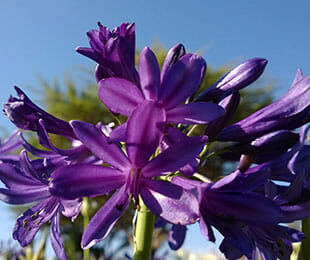Releasing the Secret to Effective Agapanthus Farming: Tips and Tricks for a Flourishing Yard
In the world of horticulture, cultivating agapanthus effectively requires a tactical technique that incorporates different elements of plant care. By understanding the subtleties of agapanthus farming, one can produce a setting where these plants grow and grow generously.
Growing Agapanthus: Finest Practices
When growing Agapanthus, appropriate dirt prep work is essential for ensuring successful growth and development of these stunning blossoms. Agapanthus, typically recognized as Lily of the Nile or African lily, prospers in well-draining dirt with a slightly acidic to neutral pH level - Agapanthus. Before growing, it is critical to modify hefty clay soils with natural issue such as garden compost or peat moss to enhance drain and supply essential nutrients for the plants
To grow Agapanthus, select a place that obtains full sunlight to partial color, as this will certainly promote healthy and balanced growth and bountiful flowering. Dig an opening twice the size of the plant's root sphere and place the Agapanthus at the very same deepness it was formerly expanding. Gently backfill the hole with dirt, pushing down securely to get rid of any kind of air pockets around the roots.
Water the newly grown Agapanthus extensively and remain to keep the soil uniformly moist, specifically throughout the plant's active expanding season. Agapanthus. Applying a well balanced plant food once a month can further sustain the plant's growth and blooming. By adhering to these best practices for planting Agapanthus, you can create a stunning display of these captivating flowers in your garden
Ideal Dirt Issues for Agapanthus
For optimal development and blooming success of Agapanthus plants, guaranteeing the soil problems are excellent is crucial. Agapanthus favors soil that is abundant in nutrients, so including a well balanced plant food during the expanding season can advertise healthy development and vibrant blossoms.

Watering and Fertilizing Tips
To make certain healthy and balanced growth and vibrant flowers, correct watering and fertilizing methods are necessary for effective Agapanthus growing. Agapanthus plants profit from normal watering, specifically during the growing period.
When it pertains to fertilizing Agapanthus, a balanced fertilizer with equivalent components nitrogen, phosphorus, and potassium can be applied in the springtime to advertise healthy growth and flowering. Slow-release fertilizers are excellent for giving nutrients slowly over an extended duration. Avoid over-fertilizing, as this can bring about extreme vegetation growth at the expense of blossoms.
Furthermore, incorporating natural matter like garden compost right into the soil can enhance nutrient degrees and improve dirt structure, assisting in the overall health and wellness of the Agapanthus plants. By following these watering and feeding suggestions, gardeners can guarantee their Agapanthus plants thrive and create magnificent displays of blossoms.
Pruning and Deadheading Strategies
Appropriate trimming and deadheading techniques play an essential duty in preserving the wellness and visual appeals of Agapanthus plants, complementing the crucial methods of watering and feeding for successful cultivation. Pruning Agapanthus entails eliminating invested flower heads, dead or yellowing fallen leaves, and overall shaping of the plant to promote much better development. Deadheading, the procedure of removing faded blossoms, not just enhances the plant's appearance yet also motivates further blooming.
When deadheading Agapanthus, it is recommended to trim off the blossom stem at the base using sharp, clean shears. This procedure reroutes the plant's power from seed manufacturing back right into origin and vegetation development, advertising a healthier and a lot more durable plant. Regular deadheading can extend the flowering duration of Agapanthus and protect against self-seeding, which can cause congestion.
In terms of trimming, Agapanthus normally advantages from a light trim after flowering to tidy up the plant and encourage fresh growth. Reducing the spent flower stems and removing any kind of dead or damaged vegetation assists maintain the plant's vigor and general look. However, it is vital to avoid cutting into the crown of the plant, as this can compromise its health.

Protecting Agapanthus From Vermins and Diseases
Executing reliable insect and disease monitoring techniques is crucial to guarding the health and vitality of Agapanthus plants in farming. Agapanthus are normally hardy plants, but they can still fall victim to different insects and conditions if not properly cared for. One common pest that affects Agapanthus is the Agapanthus borer, a caterpillar that tunnels right into the plant, causing damage to the flowers and fallen leaves. To avoid invasions, regular assessment of the plants is vital. If borers are found, they can be manually eliminated, or insecticidal soap go to this web-site can be utilized as a control procedure.
In enhancement to pests, Agapanthus are prone to illness such as origin rot and fungal leaf areas. By staying cautious and addressing bug and illness issues quickly, garden enthusiasts can assist their Agapanthus flourish and flourish.

Conclusion
To conclude, effective farming of agapanthus needs correct planting techniques, perfect dirt conditions, sufficient watering and feeding, regular trimming and deadheading, and defense from illness and parasites. By adhering to these ideas and methods, garden enthusiasts can make certain a flourishing garden full of gorgeous agapanthus flowers. Agapanthus. Remember to maintain consistent care and interest to information to advertise the wellness and longevity of these magnificent More Bonuses plants
When planting Agapanthus, appropriate dirt preparation is crucial for making certain effective growth and development of these gorgeous flowers.Water the newly grown Agapanthus thoroughly and continue to keep the dirt uniformly damp, especially throughout the plant's active growing period.For company website optimum growth and blooming success of Agapanthus plants, making sure the soil conditions are suitable is important. When hair transplanting or growing Agapanthus, ensure the soil is well-prepared to supply the required structure for the plants to develop themselves effectively. One common pest that influences Agapanthus is the Agapanthus borer, a caterpillar that tunnels right into the plant, triggering damage to the leaves and blossoms.